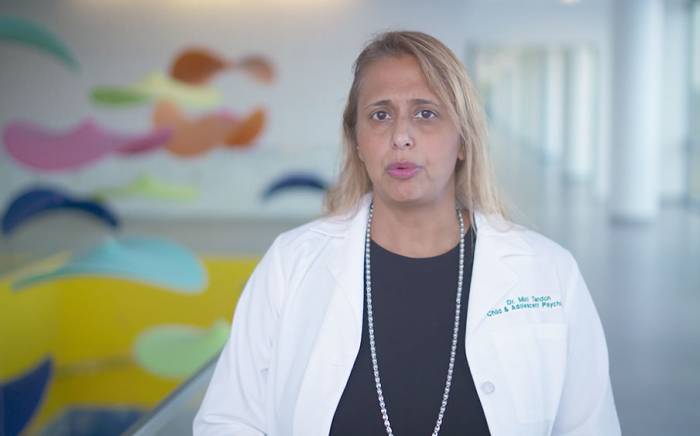The following case study was used by Andrew J. White, James P. Keating, MD, professor of pediatrics and division director of pediatric rheumatology, Washington University School of Medicine, and director of the St. Louis Children’s Pediatric Residency Program, as part of the “Patient of the Week” (POW) series. Many of the POW case studies cover uncommon illnesses, or common illnesses with unusual symptoms that can be overlooked. If you would like to be added to the POW e-mail distribution, send an email to white_a@kids.wustl.edu.
Subject: 21-month-old boy with CC (cough and congestion):
Parents noticed some coughing, nasal congestion and abdominal breathing and took him to the local ER. He underwent an NP swab that was positive for rhinovirus and enterovirus. He was tachypneic with a respiratory rate in the 60s, but stable on room air. He was given one albuterol treatment without improvement. CBC and BMP were unremarkable except for microcytic anemia.
Chest X-ray: Cardiac silhouette was slightly enlarged. Diffuse periosteal thickening of each humerus and widening of the humeral metaphyses was noted.
He was not fully immunized, and he has not seen his pediatrician on a regular basis. He does not walk and stands for only a few seconds without assistance.
He was given a dose of ceftriaxone and a normal saline bolus and transferred here.
Floor Arrival PE:
• HEENT: Clear nasal discharge.
• Pulmonary: Course inspiratory breath sounds. Referred upper airway sounds. Diffuse expiratory crackles.
• No wheezes. Mild intercostal retractions.
• Cardiovascular: Regular rate and rhythm. Normal S1 and S2. Soft II/VI murmur best heard at left upper.
• Sternal border, no rubs or gallops.
• Abdomen: Soft, distended, non-tender, no splenomegaly, normoactive bowel sounds. Liver palpated about 1 cm below costal margin.
• Extremities: No clubbing, cyanosis or edema. Protrusions at epiphyses bilaterally of wrists and knees.
• Neurologic: Awake, alert. Shakes head no to every question. Sits unassisted. Stands with assistance but whimpers.
Radiographs: No acute or healing fracture is seen. There is diffuse metaphyseal widening and fraying with extensive periosteal reaction, which is seen along the upper and lower extremities and the ribs. The bone mineralization is decreased. There is cupping of the rib costochondral junctions.
Additional History: He has been a largely healthy baby until this hospitalization. He has been breastfeeding since birth with no vitamin supplementation or salient dairy intake. Eats basically his family’s diet, as appetite dictates, about q1-2hr (generally healthy with intake of green vegetables). He receives minimal sunlight exposure (10hr/month), the family generally stays indoors. He is not taking any medications.
Labs: 25 OH Vitamin D: <8 PTH: 168 Ca: 9.7 Phos: 2.5 Alk Phos 934
Diagnoses:
1. Vitamin D deficiency rickets.
2. Iron deficiency anemia.
3. Slowed weight gain due to inadequate caloric intake.
Plan:
1. Vitamin D3 (cholecalciferol) 50,000 units PO x 1 followed by dosing of 2,000 units daily x 2-3 months.
2. Calcium carbonate 700 mg elemental calcium daily.
3. Recheck calcium level in 24 hours to be sure “hungry bone syndrome” does not result in hypocalcemia.
4. Repeat X-ray for evidence of healing in 2-4 wks.
5. Iron supplementation.
6. Improve access to healthy diet.
In 1989 some pediatricians and breastfeeding advocates decided that breastfed babies didn’t need supplemental vitamin D. Despite warnings that that advice would invite a return of rickets, the use of vitamin supplements decreased, particularly in infants cared for by pediatricians trained after 1989. In the 1990s an epidemic of vitamin D deficiency especially, but not exclusively, in breastfed African-American infants was documented in Missouri as in other states. This led in 2003 to a new AAP recommendation that all breastfed infants should receive vitamin D 200 I Units/day starting no later than age 2 months. Physicians working in our newborn nurseries in St. Louis began recommending vitamin D to all breastfeeding mothers (2001) two years before the official recommendation, and many of our residents made the change a year (2000) before that. We now see 0-2 infants each spring compared to the 4-8/year we were seeing before 2002.
Most infants with vitamin D deficiency do not have slowed weight gain and iron deficiency but a sizable minority (45%) do, usually due to inadequate milk supply. There is insufficient vitamin D in breast milk to prevent rickets. There is insufficient iron to prevent iron deficiency, which occurs earlier in infants who were premature who have lower iron stores. Babies who do not take sufficient breast milk to meet their caloric needs should have an effort to increase milk production and, if unsuccessful, supplement with formula, continuing the breast if possible and desired by mother.
Additional lessons about infants with vitamin D deficient rickets:
- 25 hydroxy vitamin D will be low; 1,25 hydroxy vitamin D will be normal or high. If you order only the 1,25 hydroxy vitamin D and think it should be low, you may misdiagnose the problem as renal or calcium deficient rickets.
- There are no X-ray findings in 20% of rachitic infants.
- Onset can be in utero or anytime thereafter. One of our infants was 2 months old and another was 4 months old. In both mothers’ serum 25 hydroxy D was unmeasurably low (non-milk drinkers, not receiving pre-natal vitamins or calcium).
- Giving high-dose vitamin D and calcium over one day (stosstherapy) in hospital is effective and safe.
- Rickets may present with serendipitous recognition on X-ray done for another reason, or seizures, heart failure, hypotonia, delayed gross motor development, stridor, or death.
- Unlike infantile scurvy, rickets is not usually painful.
References
- Kreiter SR, Schwartz RP, Kirkman HN, Jr., Charlton PA, Calikoglu AS, Davenport ML. Nutritional rickets in African-American breast-fed infants. J Pediatr 2000; 137(2):153-157.
- Dewey KG. Nutrition, growth and complementary feeding of the breastfed infant. Pediatr Clin North Am 2001; 48(1):87-104.
- Domellöf M, Cohen RJ, Dewey KG, Hernell O, Rivera LL, Lönnerdal B. Iron supplementation of breastfed Honduran and Swedish infants from 4 to 9 months of age. J Pediatr 2001; 138(5):679-687.
- Shah BR, Finberg L. Single-day therapy for nutritional vitamin D-deficiency rickets: a preferred method. J Pediatr 1994; 1994 Sep;125(3):487-490.







